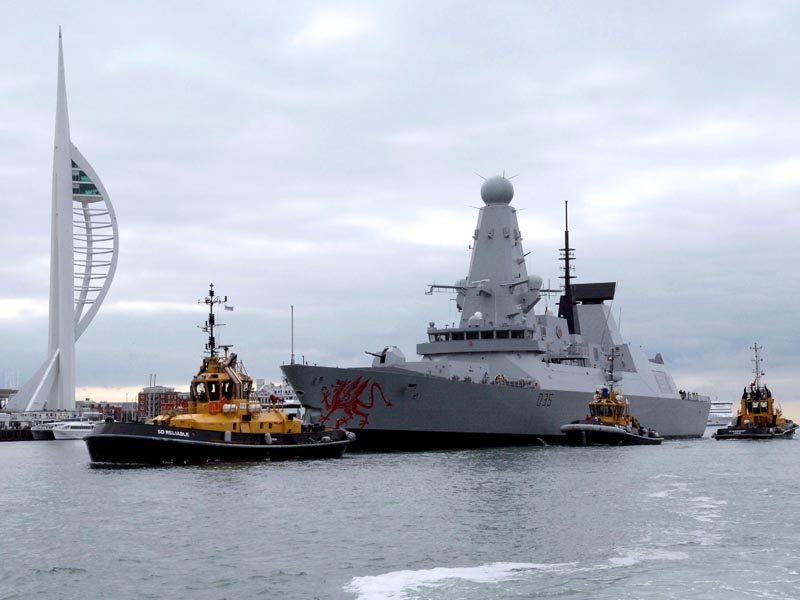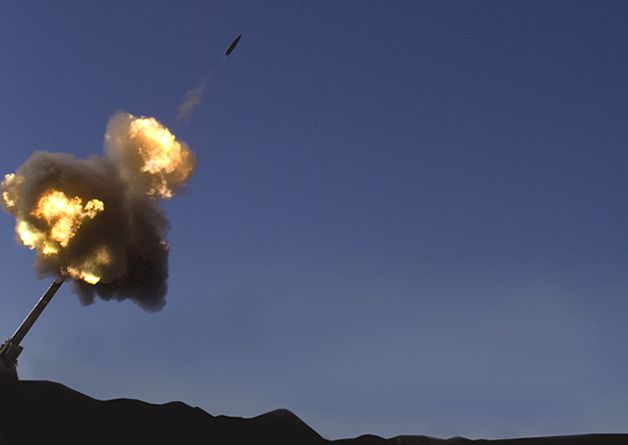The sixth and last of the Royal Navy’s new generation of Type 45 destroyers, HMS Duncan, has been formally welcomed into the fleet at a “christening” ceremony. Hundreds of guests, including families of the 190-strong crew, attended the event at Portsmouth Naval Base to mark the ship’s acceptance into frontline service.
The Royal Navy views the event as a significant milestone for the fleet as it is the final commissioning ceremony for the six vessels which are the most powerful ships ever built for the senior service. The first, HMS Daring, was commissioned in July 2009 and was followed by sister ships Dauntless, Diamond, Dragon, Defender and now Duncan.
Principal guests included Lady Marie Ibbotson – the ship’s sponsor, who launched the vessel at BAE Systems’ Govan shipyard on the River Clyde in October 2010 – and First Sea Lord Admiral Sir George Zambellas. Dignitaries from the ship’s affiliated cities of Belfast and Dundee and veterans from the last HMS Duncan – a Type 14 frigate in service between 1957 and 1985 – were also present. Also attending was Sir Robin Knox-Johnston, the first man to sail solo non-stop around the world, who served on board the previous HMS Duncan.
Commander James Stride, Duncan’s commanding officer (CO), said the event was a proud moment for all personnel serving in the ship. He said: “To command a new ship is an immense privilege, one for which I will forever be grateful. “But this impressive ship, one of a class of the most advanced air destroyers in the world, is nothing without its ship’s company. “I am blessed by a highly professional ship’s company who are extremely proud of being Duncanites.”
Lieutenant Commander John Bullock, the ship’s marine engineer, has extended his career in the navy so he can serve on the previous HMS Duncan, an anti-submarine frigate, and the new one. The 51-year-old from Falmouth, Cornwall, said: “I joined the navy in 1982 as a marine engineer apprentice and the previous Duncan was a training ship at that time.
“I was due to leave the navy later this year but then I got a phone call saying ‘John, we have a job for you, would you like to be on the new HMS Duncan?’ “What a privilege to have my career extended to serve on this ship – there are a pair of Duncan bookends at either end of my career.”
Leading seaman Chris Young, 25, from Northampton, said: “It’s a very proud day for the ship and her company. “The sea trials have allowed us to show off the vessel to the fleet and the admiralty but to show her off to our friends and family is really important for all of her crew. “We need to put everything in context for them, to actually show them what we do on a day-to-day basis is really important for us and very rewarding.”
The hour-long ceremony finished in traditional Royal Navy fashion with the cutting of a commissioning cake by the CO’s wife, Emma, along with the youngest member of the ship’s company – Logistician (Steward) Clancey Welford, aged 18.
The first four Type 45s have already experienced active service on operational deployments and the fifth – HMS Defender – is due to deploy for the first time next year. Once commissioned, HMS Duncan will continue an intense period of trials and training around the UK lasting into next year before being ready to undertake operational roles.
The Type 45 destroyers are the most advanced warships the nation has ever built and have already deployed operationally to the Middle East and across the Atlantic. Their mission is to shield the fleet from air attack using the Sea Viper missile which can knock targets out of the sky up to 70 miles away.
The Type 45s can also be used as general-purpose warships. They have flight decks big enough to accommodate helicopters up to the size of a Chinook and there is enough space on board to host a Royal Marines detachment of up to 60 personnel. Living quarters have also been upgraded with no mess square taking more than six people and no communal toilets or showers.
All six Type 45s are based in Portsmouth and will serve until about 2040.











